Design and Development of Software for the SILAR Control Process Using a Low-Cost Embedded System
Abstract
1. Introduction
2. Materials and Methods
2.1. Deposition of Thin Films by SILAR Process
2.2. Automation of the SILAR PROCESS
3. Results
3.1. Design of the Physical Structure of the Automated SILAR Prototype
- Touchscreen used as the Human–Machine Interface (HMI).
- PIC18F4550 Microcontroller.
- XL4016 DC/DC converter module.
- EN817 opto-coupler.
- EN817 opto-coupler.
- HY-DIV268N-5A stepper motor driver.
- Main 24 V DC power supply.
3.2. Software Design for the Automated SILAR Prototype
3.3. Electronic System Design
- Outputs assigned to actuators.
- Sensor and button inputs.
- Serial communication to the HMI.
4. Discussion
4.1. Development of the Graphical Interface
4.2. Electronic Circuit Final Implementation
4.3. Final Implementation of the Automated SILAR Prototype
4.4. Functionality Tests
5. Conclusions
Author Contributions
Funding
Institutional Review Board Statement
Informed Consent Statement
Data Availability Statement
Acknowledgments
Conflicts of Interest
References
- Pérez-Martínez, D.; Gonzaga-Sánchez, J.D.; De Bray-Sánchez, F.; Vázquez-García, G.; Escorcia-García, J.; Nair, M.T.S.; Nair, P.K. Simple solar cells of 3.5% efficiency with antimony sulfide-selenide thin films. Phys. Status Solidi Rapid Res. Lett. 2016, 10, 388–396. [Google Scholar] [CrossRef]
- Tirado Guerra, S. SnO2:Agn thin films prepared by sol-gel applied as propane gas sensors. Rev. Mex. Ing. Quím. 2015, 14, 691–701. Available online: http://www.rmiq.org/ojs311/index.php/rmiq/article/view/1385/617 (accessed on 21 February 2021).
- Olvera, M.; Asomoza, R. Detectores de CO a base de películas delgadas de SnO2. Rev. Mex. Fis. 1996, 42, 561–572. Available online: https://rmf.smf.mx/ojs/rmf/article/download/2596/2564 (accessed on 15 April 2021).
- Suresh-Kumar, P.; Dhayal Raj, A.; Mangalaraj, D.; Nataraj, D. Hydrophobic ZnO nanostructured thin films on glass substrate by simple successive ionic layer absorption and reaction (SILAR) method. Thin Solid Films 2010, 518, 183–186. [Google Scholar] [CrossRef]
- Dholam, R.; Patel, N.; Adami, M.; Miotello, A. Physically and chemically synthesized TiO2 composite thin films for hydrogen production by photocatalytic water splitting. Int. J. Hydrog. Energy 2008, 33, 6896–6903. [Google Scholar] [CrossRef]
- Molina, G.; Muñoz, F.; Pérez, J. Photocatalytic degradation of azo dyes with supported titanium dioxide (TiO2) on polyethylene terephthalate (PET) and polystyrene (PS). In Proceedings of the Congreso Iberoamericano de Procesos Oxidativos Avanzados, Belo Horizonte, Brasil, 3–6 November 2015. [Google Scholar]
- Barrios-Salgado, E.; Rodríguez-Lazcano, Y.; Pérez-Orozco, J.P.; Garcia-Angelmo, A.R. A new route for the synthesis of Sn3Sb2S6 thin films by chemical deposition. Rev. Mex. Ing. Quím. 2020, 19, 1363–1373. [Google Scholar] [CrossRef]
- Sene, C.; Calixto, M.E.; Dobson, K.D.; Birkmire, R.W. Electrodeposition of CuInSe2 absorber layers from pH buffered and non-buffered sulfate-based solutions. Thin Solid Films 2008, 516, 2188–2194. [Google Scholar] [CrossRef]
- Barrera-Calva, E.; Martínez-Flores, J.C.; Avila-García, A.; Rodil, S.; Huerta-Arcos, L.; Viveros-García, T. Superficial characterization of Co and Co-Fe oxide films. Rev. Mex. Ing. Quím 2005, 4, 147–156. Available online: http://rmiq.org/ojs311/index.php/rmiq/article/view/2100/1092 (accessed on 22 February 2021).
- Kumar, V.; Sharma, M.K.; Gaur, J.; Sharma, T.P. Polycrystalline ZnS thin films by screen printing method and its characterization. Chalcogenide Lett. 2008, 5, 289–295. Available online: https://chalcogen.ro/Kumar.pdf (accessed on 22 February 2021).
- Ilican, S.; Caglar, Y.; Caglar, M. Preparation and characterization of ZnO thin films deposited by sol-gel spin coating method. J. Optoelectron. Adv. Mater. 2008, 10, 2578–2583. [Google Scholar]
- Çayir Tasdemirci, T. Synthesis of copper doped nickel oxide thin films: Structural and optical studies. Chem. Phys. Lett. 2020, 738, 16884. [Google Scholar] [CrossRef]
- Congiu, M.; Decker, F.; Dini, D.; Graeff, C.F.O. An open-source equipment for thin film fabrication by electrodeposition, dip-coating, and SILAR. Int. J. Adv. Manuf. Technol. 2016, 87, 2901–2909. [Google Scholar] [CrossRef]
- Garzón, D.; Martínez, A.; Rico, D.; Vargas, C. Sistema SILAR de producción para películas semiconductoras aplicadas en sensores de humedad. In Proceedings of the XVI Convención Científica de Ingeniería y Arquitectura, La Habana, Cuba, 26–30 November 2012; Universidad Nacional de Colombia: Bogotá, Colombia, 2012; pp. 1–10. [Google Scholar]
- Garzon, D.; Martínez, A.; Rico, D.; Guzmán, D.; Vargas, C. Sistema SILAR para el crecimiento de películas semiconductoras con diferentes aplicaciones. Rev. Investig. Univ. Quindío 2012, 23, 16–22. [Google Scholar] [CrossRef]
- Jaramillo, T.; Sung-Hyeon, B.; Kleiman-Shwarsctein, A.; Kyoung-Shin, C.; Struky, G.; McFarland, E. Automated Electrochemical Synthesis and Photoelectrochemical Characterization of Zn1-x CoxO Thin films for Solar Hydrogen Production. J. Comb. Chem. 2005, 7, 264–271. Available online: https://pubs.acs.org/doi/pdf/10.1021/cc049864x (accessed on 22 February 2021). [CrossRef] [PubMed]
- Santos, J.V.A.; Santos, C.P.; Macedo, M.A. Design and Construction of a Spinner using Low Cost Materials. Sci. Plena 2012, 8, 033402-1. Available online: https://www.scientiaplena.org.br/sp/article/view/912/471 (accessed on 22 February 2021).
- Nagarethinam, V.S.; Arunkumar, N.; Balu, A.R.; Suganya, M.; Selvan, G. Fabrication of cadmium sulfide thin films by an automated trigger enhanced spray technique at two different substrate temperaturas. J. Electron. Dev. 2012, 14, 1108–1117. Available online: https://citeseerx.ist.psu.edu/viewdoc/download?doi=10.1.1.667.2943&rep=rep1&type=pdf (accessed on 21 February 2021).
- Valdez-Martínez, J.S.; Meneses-Arcos, M.A.; Calixto-Rodriguez, M.; Rumbo-Morales, J.Y.; Beltran-Escobar, M.A.; Villanueva-Tavira, J.; Sarmiento-Bustos, E. Automation of the successive ionic layer adsorption and reaction-SILAR-process. Rev. Mex. Ing. Química 2020, 19, 1351–1361. Available online: http://rmiq.org/ojs311/index.php/rmiq/article/view/1082/571 (accessed on 21 February 2021). [CrossRef]
- Akaltun, Y. Effect of thickness on the structural and optical properties of CuO thin films grown by successive ionic layer adsorption and reaction. Thin Solid Films 2015, 594, 30–34. [Google Scholar] [CrossRef]
- Akaltun, Y.; Çayir Tasdemirci, T. Fabrication and characterization of NiO thin films prepared by SILAR method. J. Alloys Compd. 2015, 625, 144–148. [Google Scholar] [CrossRef]
- Çayir Tasdemirci, T. Effect of different thickness and solution concentration on CuS thin film grown by SILAR method. J. Sci. Perspect. 2019, 3, 207–214. [Google Scholar] [CrossRef]
- Lindroos, S.; Leskelä, M. Growth of zinc peroxide (ZnO2) and zinc oxide (ZnO) thin films by the successive ionic layer adsorption and reaction-SILAR-technique. Int. J. Inorg. Mater. 2000, 2, 197–201. Available online: https://www.sciencedirect.com/science/article/pii/S1466604900000179 (accessed on 21 February 2021). [CrossRef]
- Pawar, S.; Pawar, B.; Kim, J.; Joo, O.; Lokhande, C. Recent status of chemical bath deposited metal chalcogenide and metal oxide thin films. Curr. Appl. Phys. 2011, 11, 117–161. [Google Scholar] [CrossRef]
- Verle, M. PIC Microcontrollers Programming in C, 1st ed.; Mikroelektronika: Belgrade, Serbia, 2021; Available online: https://www.mikroe.com/ebooks/pic-microcontrollers-programming-in-c/introduction (accessed on 21 February 2021).
- PIC18F2455/2550/4455/4550 Data Sheet. Available online: https://ww1.microchip.com/downloads/en/devicedoc/39632c.pdf (accessed on 1 April 2021).
- Mendoza, J.R. Diseño y Simulación de Sistemas Microcontrolados en Lenguaje C, 1st ed.; Mikroelektronika: Belgrade, Serbia, 2021; Available online: http://download.mikroe.com/documents/books/spa/diseno-y-simulacion-de-sistemas-microcontrolados-en-lenguaje-c/diseno-y-simulacion-de-sistemas-microcontrolados-en-lenguaje-c.pdf (accessed on 1 April 2021).
- Bolton, W. Mecatrónica—Sistemas de Control Electrónico en la Ingeniería Mecánica y Eléctrica, 6th ed.; Alfaomega: Mexico City, Mexico, 2011; pp. 401–419. [Google Scholar]
- Chapman, S.J. Máquinas Eléctricas, 6th ed.; McGraw-Hill: New York, NY, USA, 2012; pp. 436–439. [Google Scholar]
- NEMA23-AMT112S Datasheet: Description of Stepper Servo Motor. Available online: https://www.mouser.com/datasheet/2/670/nema23_amt112s-1777991.pdf (accessed on 1 April 2021).
- HY-DIV268N-5A Datasheet: Description of Step Motor Driver. Available online: http://electropro.pe/image/data/imgProductos/196.%20Driver%20de%20Motor%20Paso%20a%20Paso/HY-DIV268N-5A.pdf (accessed on 1 April 2021).
- Llopis, R.S.; Pérez, J.A.R.; Latorre, C.V.A. Automatización Industrial, 1st ed.; Universitat Jaume I: Castellón de la Plana, Spain, 2010; p. 126. [Google Scholar]
- HMI NEXTION 7” Touch Screen Datasheet. Available online: https://nextion.tech/datasheets/nx8048p070-011r/ (accessed on 1 April 2021).
- XL4016 Power Supply Datasheet. Available online: http://www.xlsemi.com/datasheet/XL4016%20datasheet.pdf (accessed on 22 April 2021).
- SN04-N Inductive Proximity Sensor Datasheet. Available online: http://www.cheemi-tech.com/pdf/Cheemi%20Inductive%20Proximity%20Sensor%20Series%20CJD-SN05.pdf (accessed on 22 April 2021).
- EN817 Opto-Coupler Datasheet. Available online: https://www.tme.eu/Document/371e110151e1c8afec5198356913d01a/EL817.pdf (accessed on 22 April 2021).
- Tocci, R.J.; Widmer, N.S.; Moss, G.L. Contadores y registros Máquina de estados. In Sistemas Digitales: Principios y Aplicaciones, 8th ed.; Pearson Education: Mexico, Mexico, 2003; pp. 425–436. [Google Scholar]
- Rincón Nigro, M.; Aguilar Castro, J.; Hidrobo Torres, F. Generación Automática de Código a Partir de Máquinas de Estado Finito. Comput. Sist. 2011, 4, 405–421. Available online: https://www.cys.cic.ipn.mx/ojs/index.php/CyS/article/view/1285/1377 (accessed on 29 March 2021).
- SolidWorks®. Available online: https://www.solidworks.com/es/category/3d-cad (accessed on 1 April 2021).
- Rakhshani, A.E. Preparation, characteristics and photovoltaic properties of cuprous oxide—A review. Solid State Electron. 1986, 29, 7–17. [Google Scholar] [CrossRef]
- Bayansal, F.; Şahin, B.; Yüksel, M.; Biyikli, N.; Çetinkara, H.A.; Güder, H.S. Influence of coumarin as an additive on CuO nanostructures prepared by successive ionic layer adsorption and reaction (SILAR) method. J. Alloys Compd. 2013, 566, 78–82. [Google Scholar] [CrossRef]
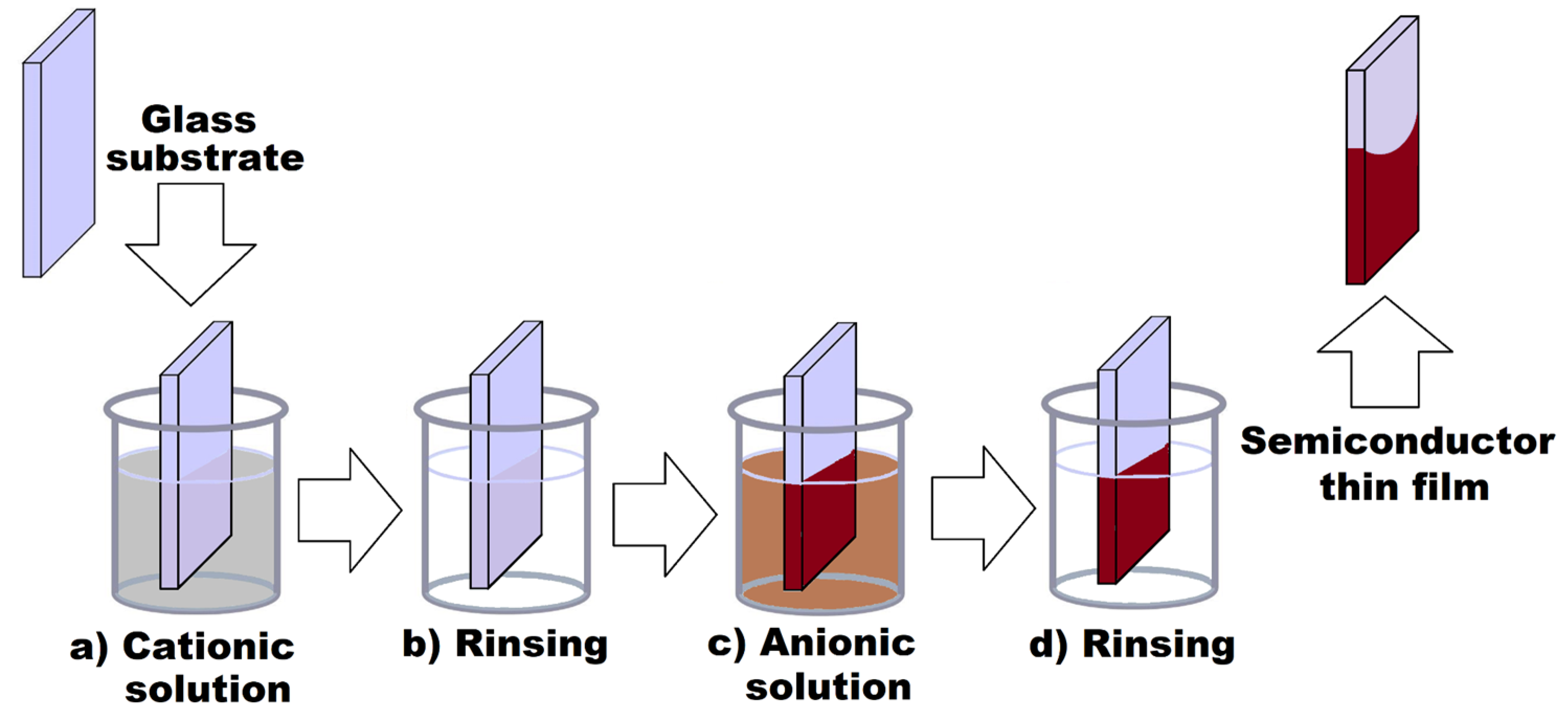
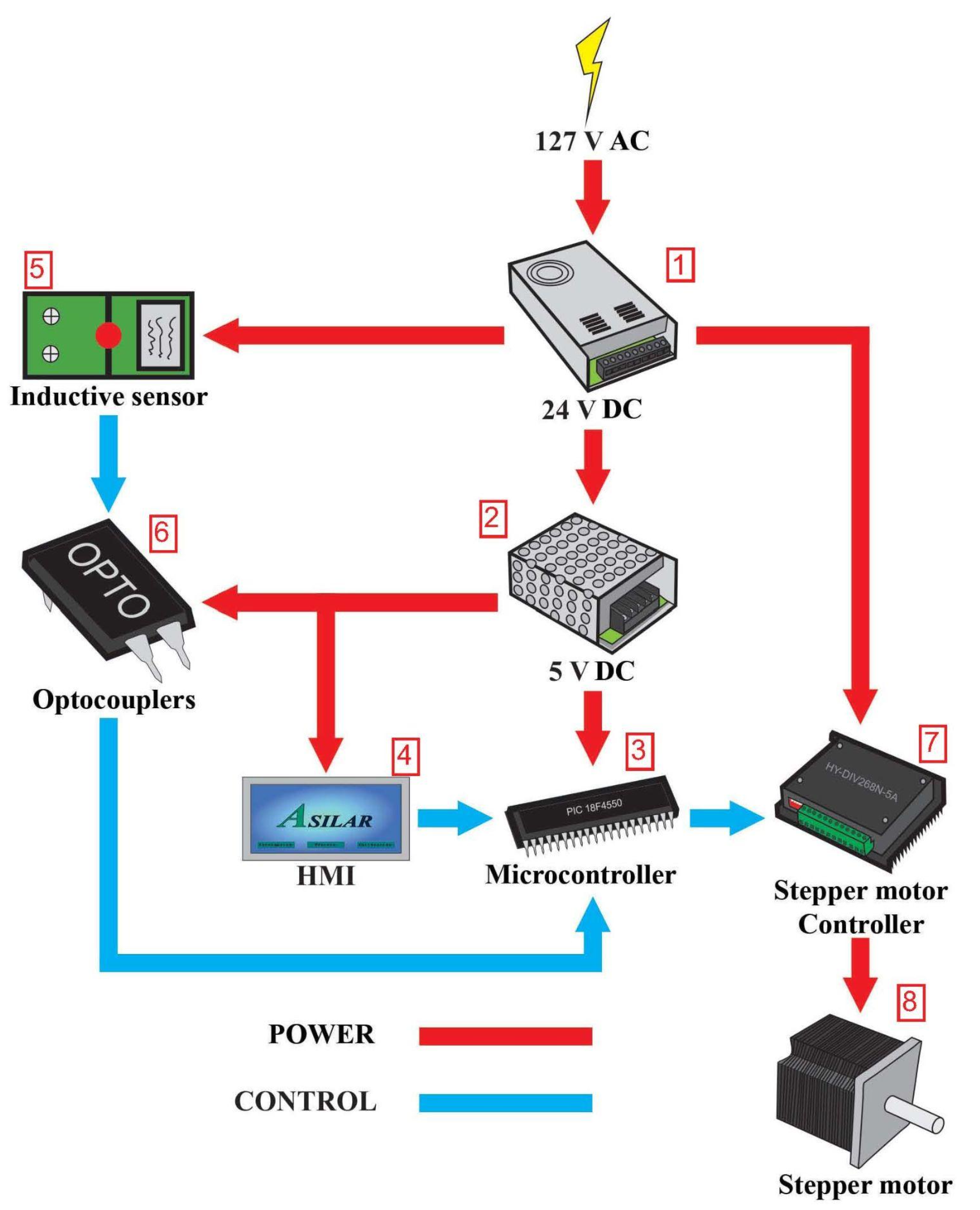



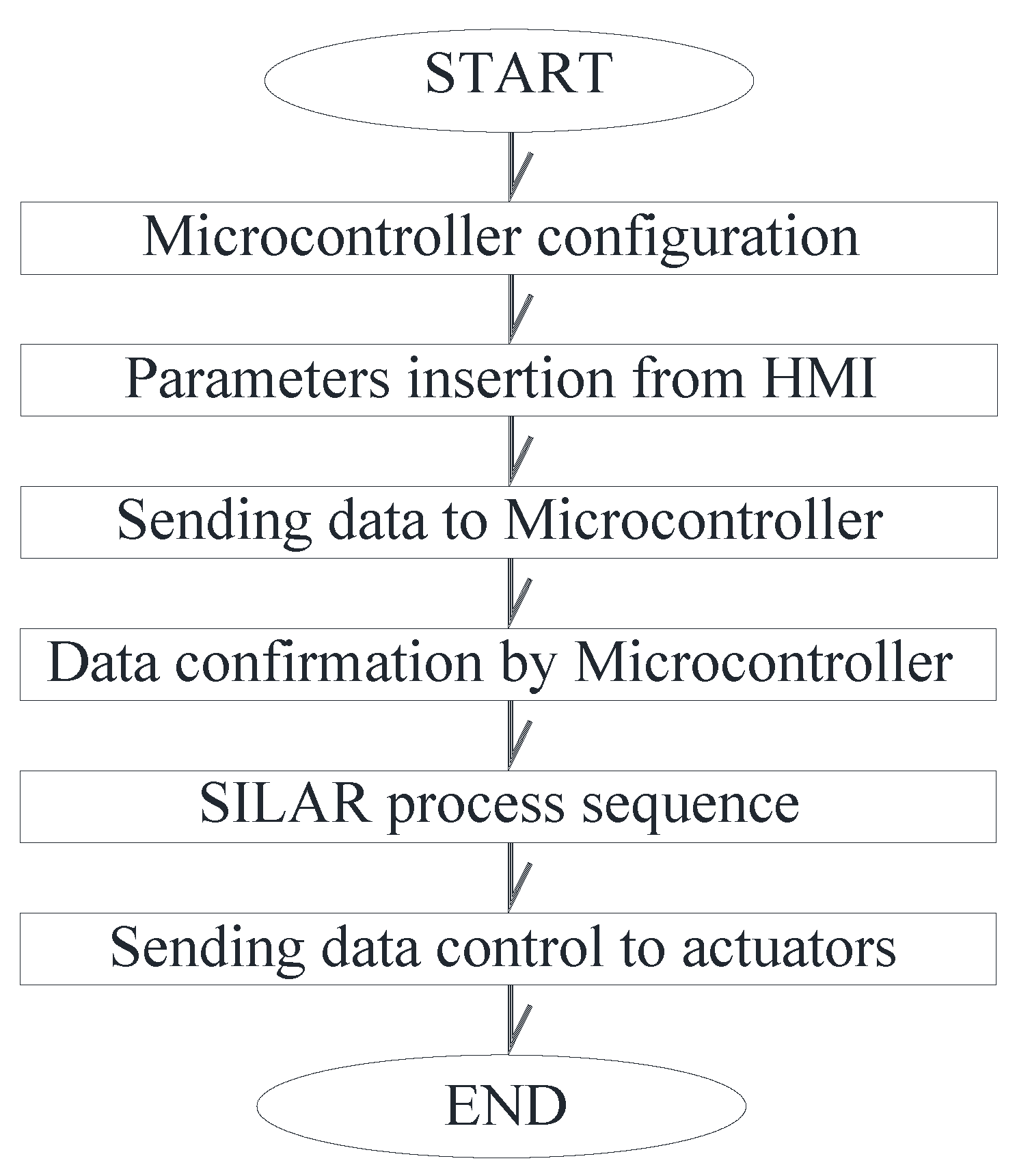
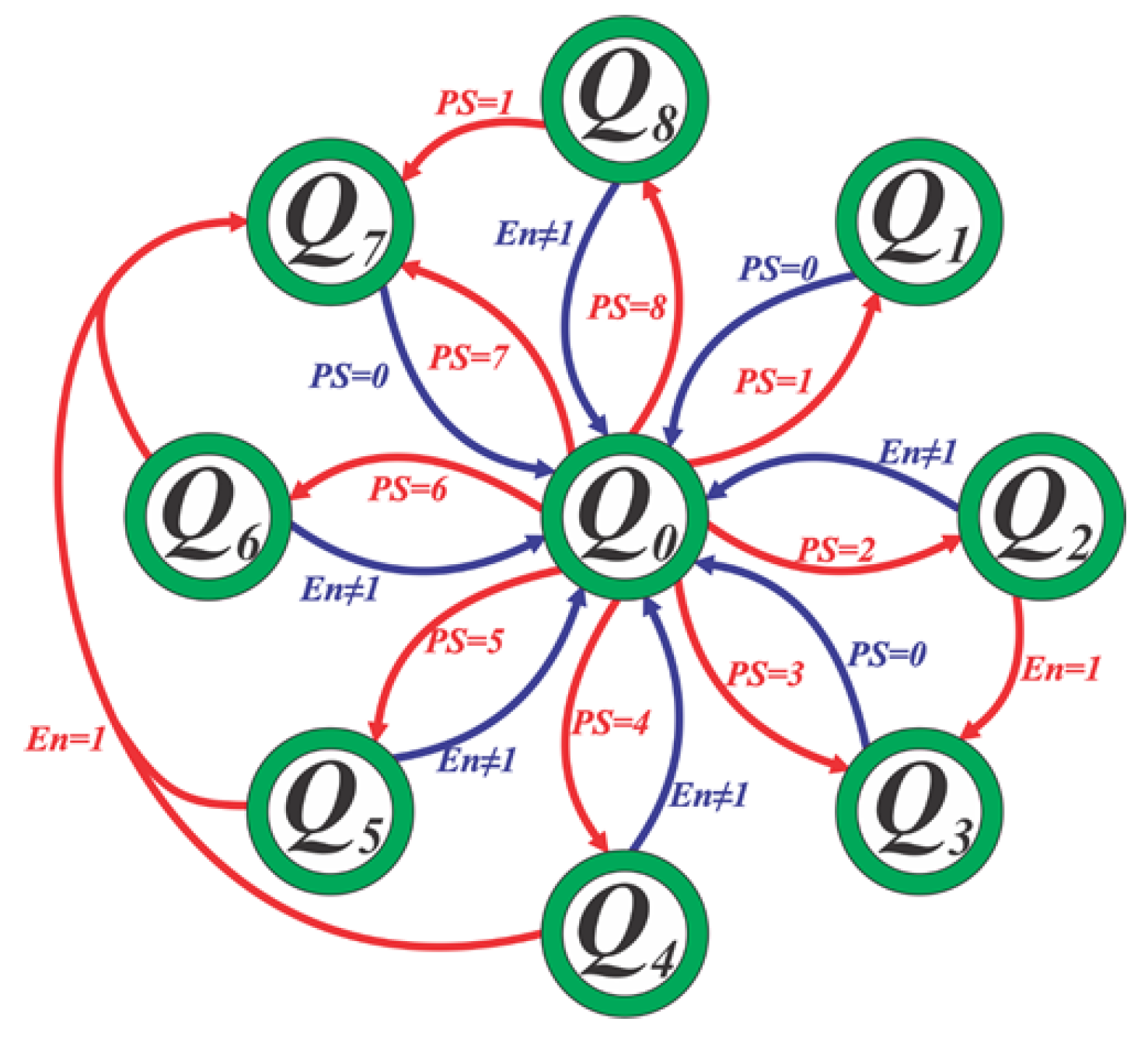
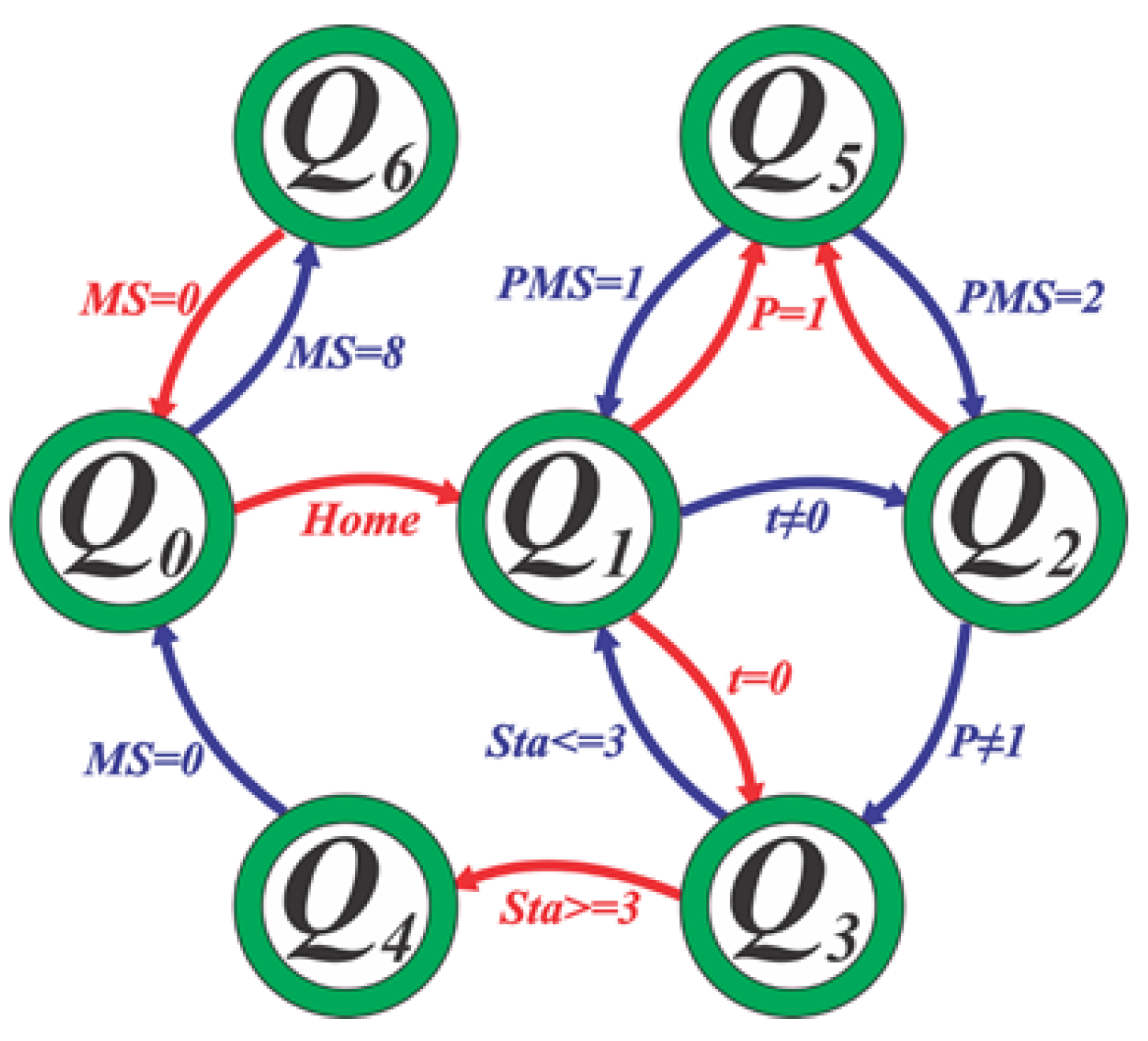

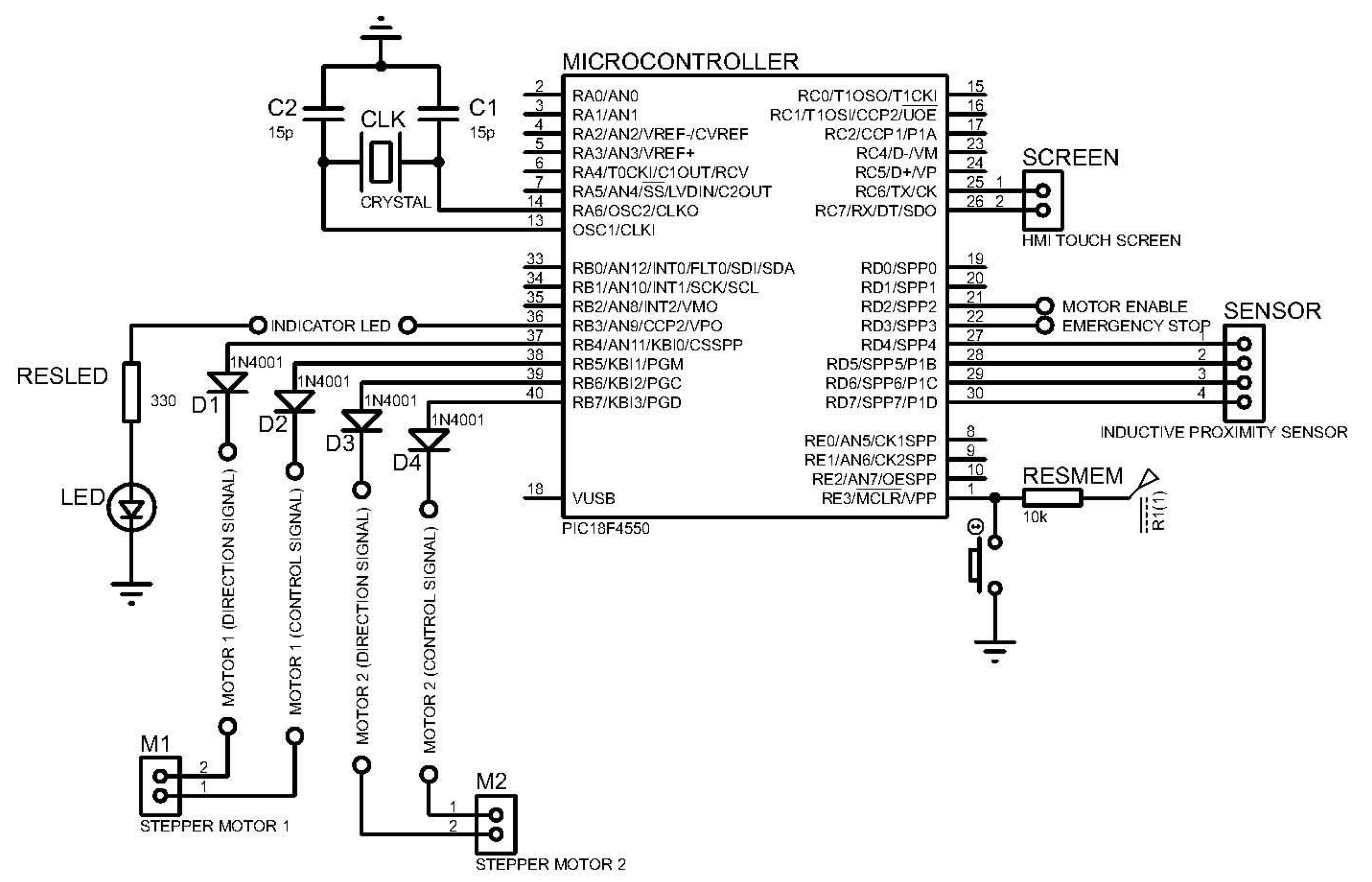

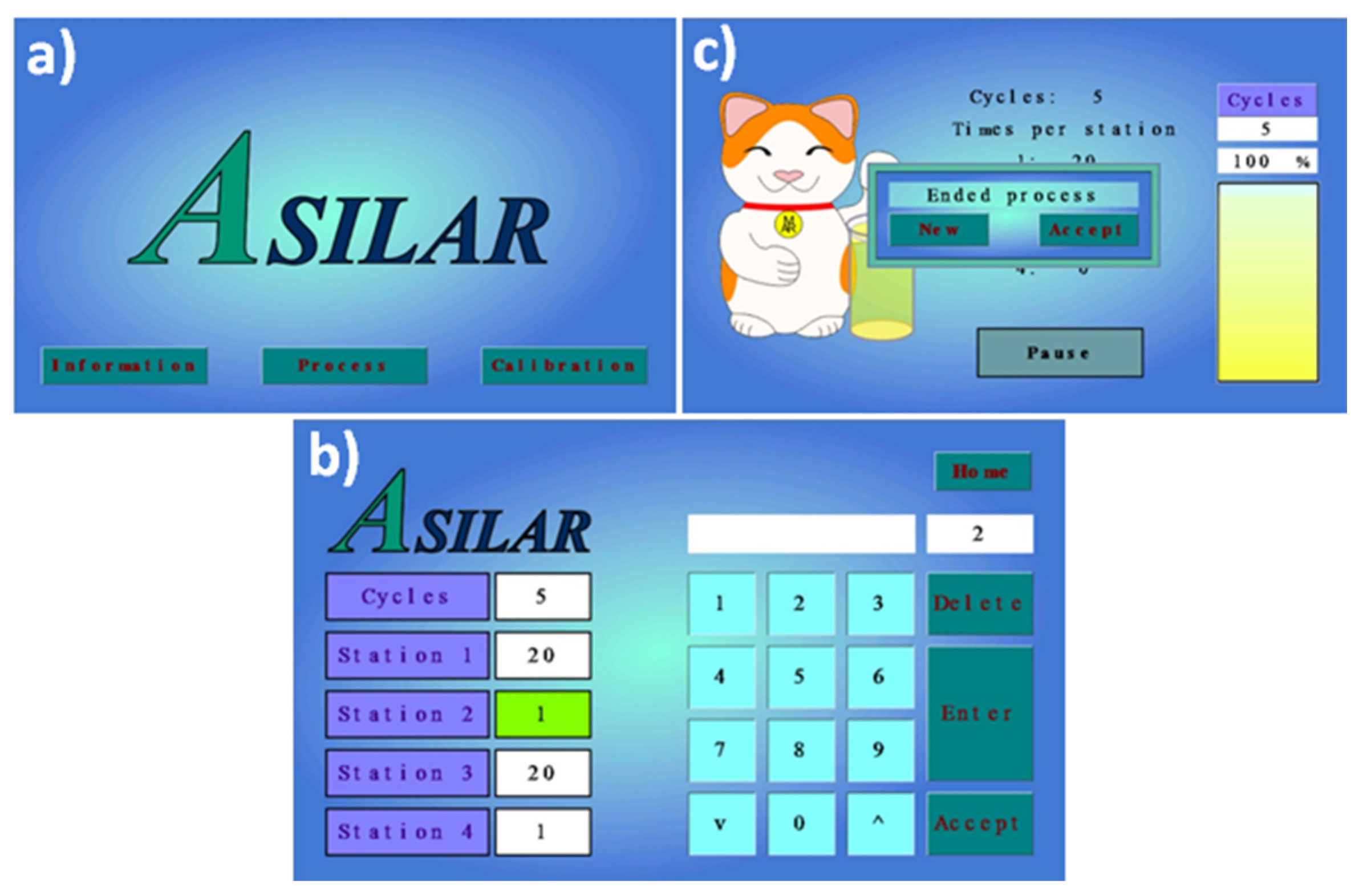
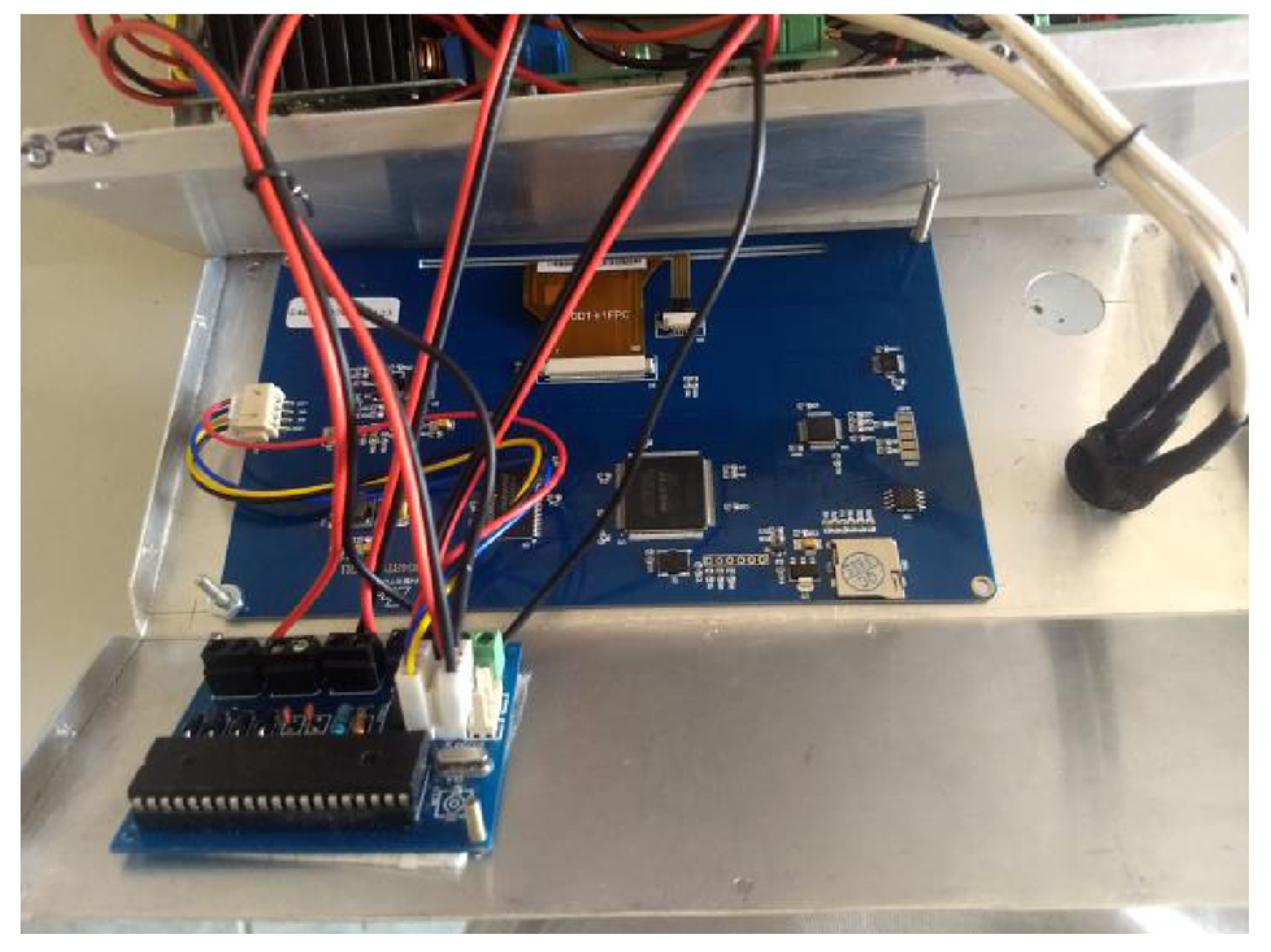
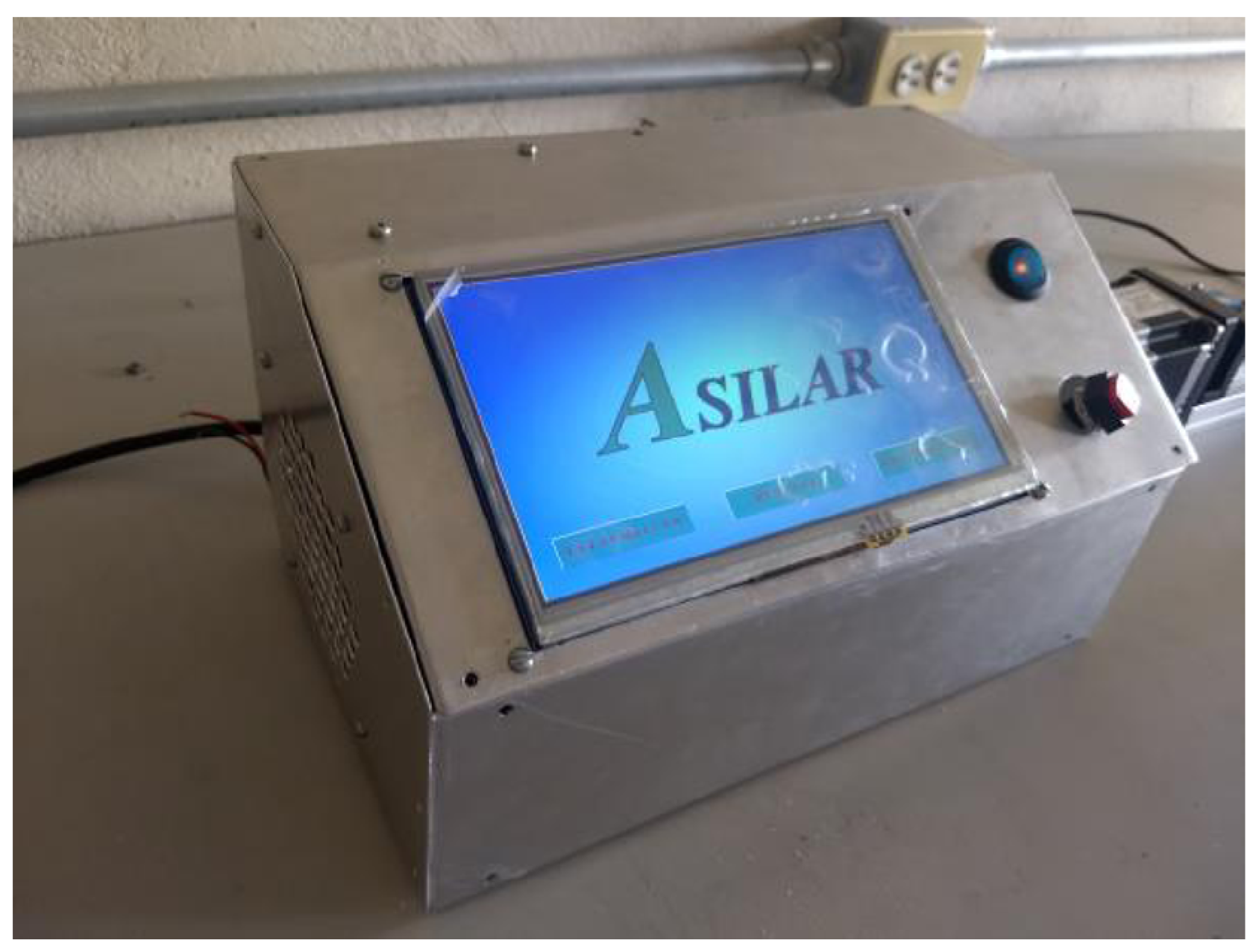

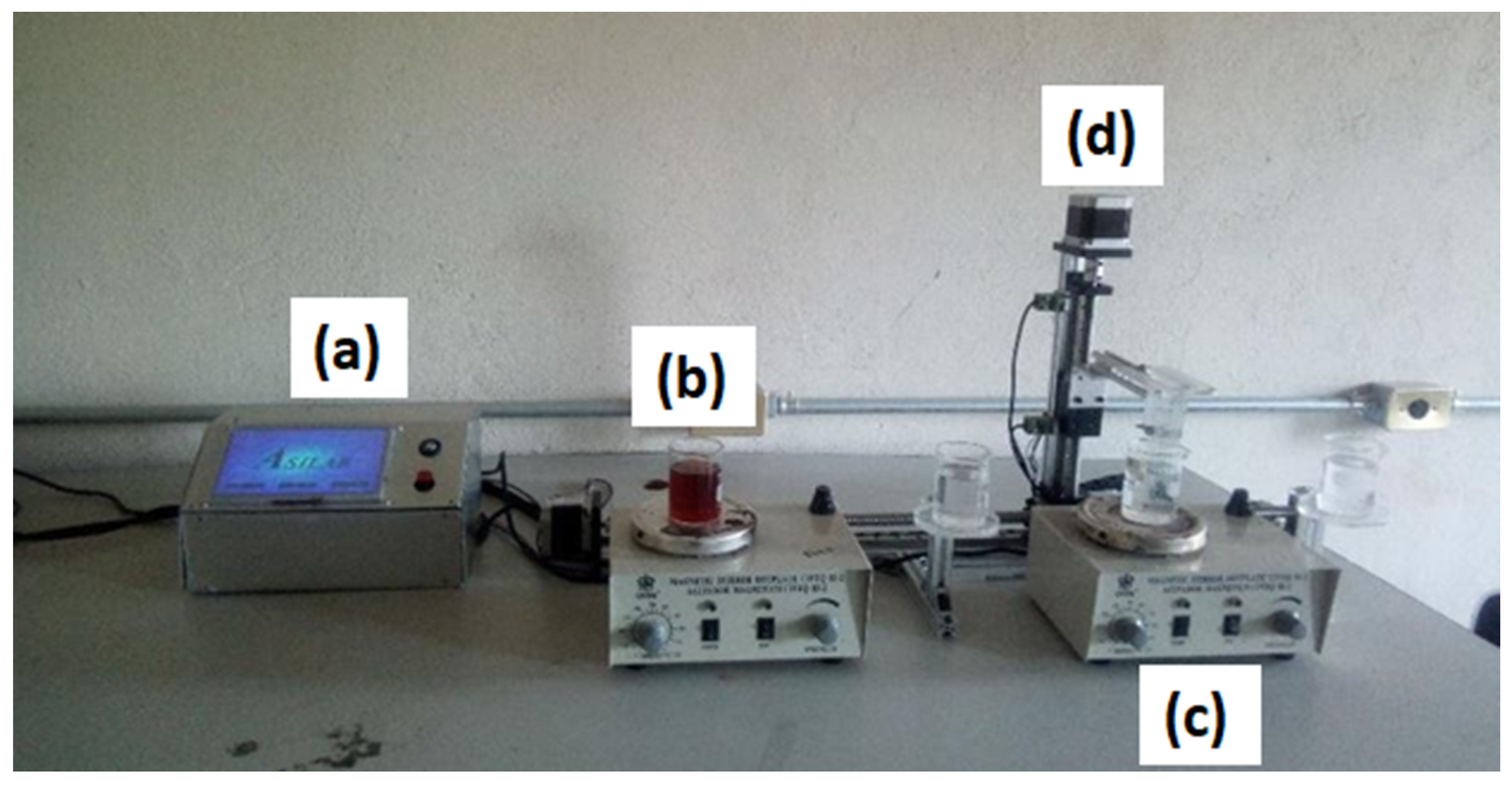
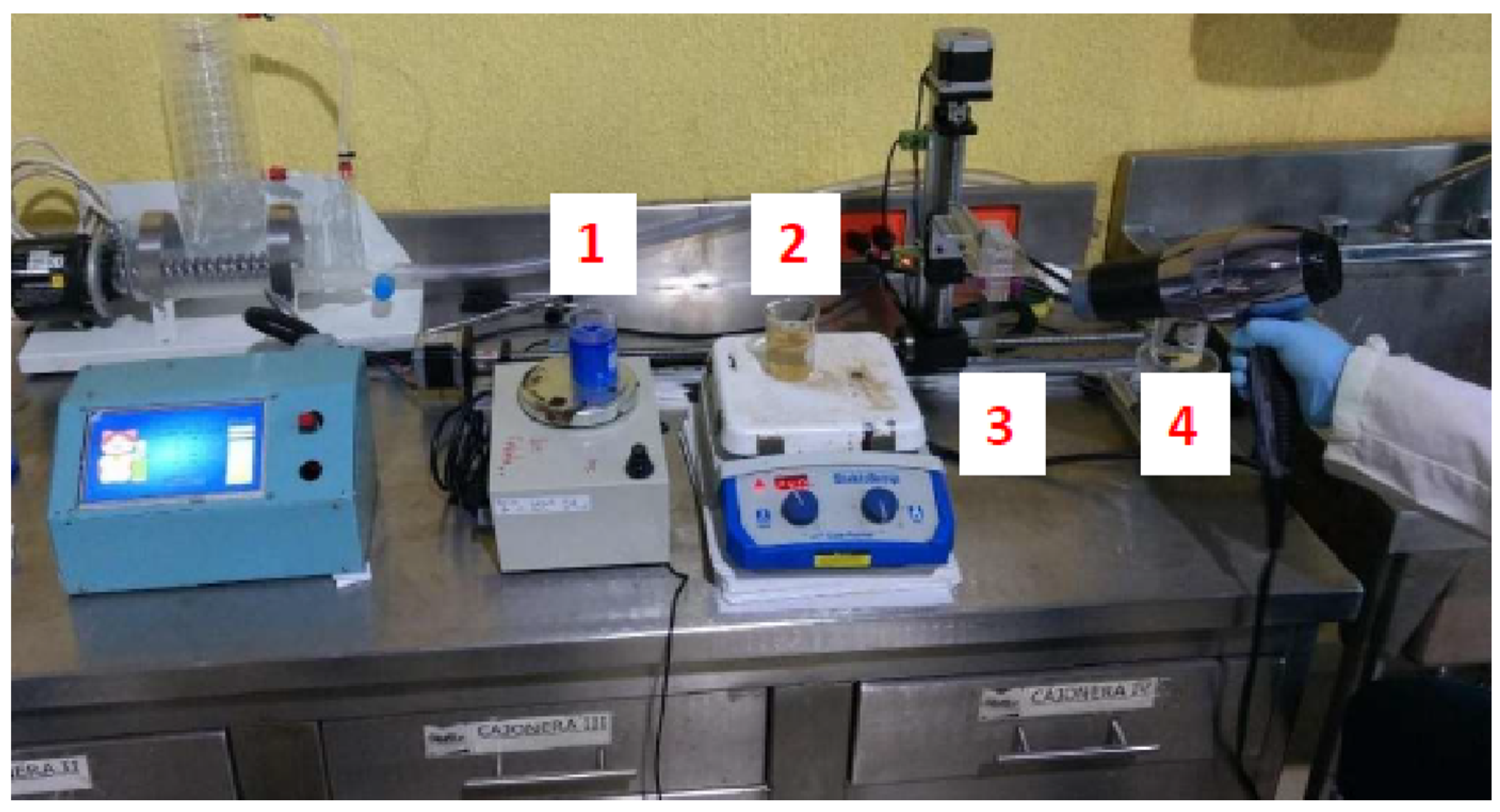
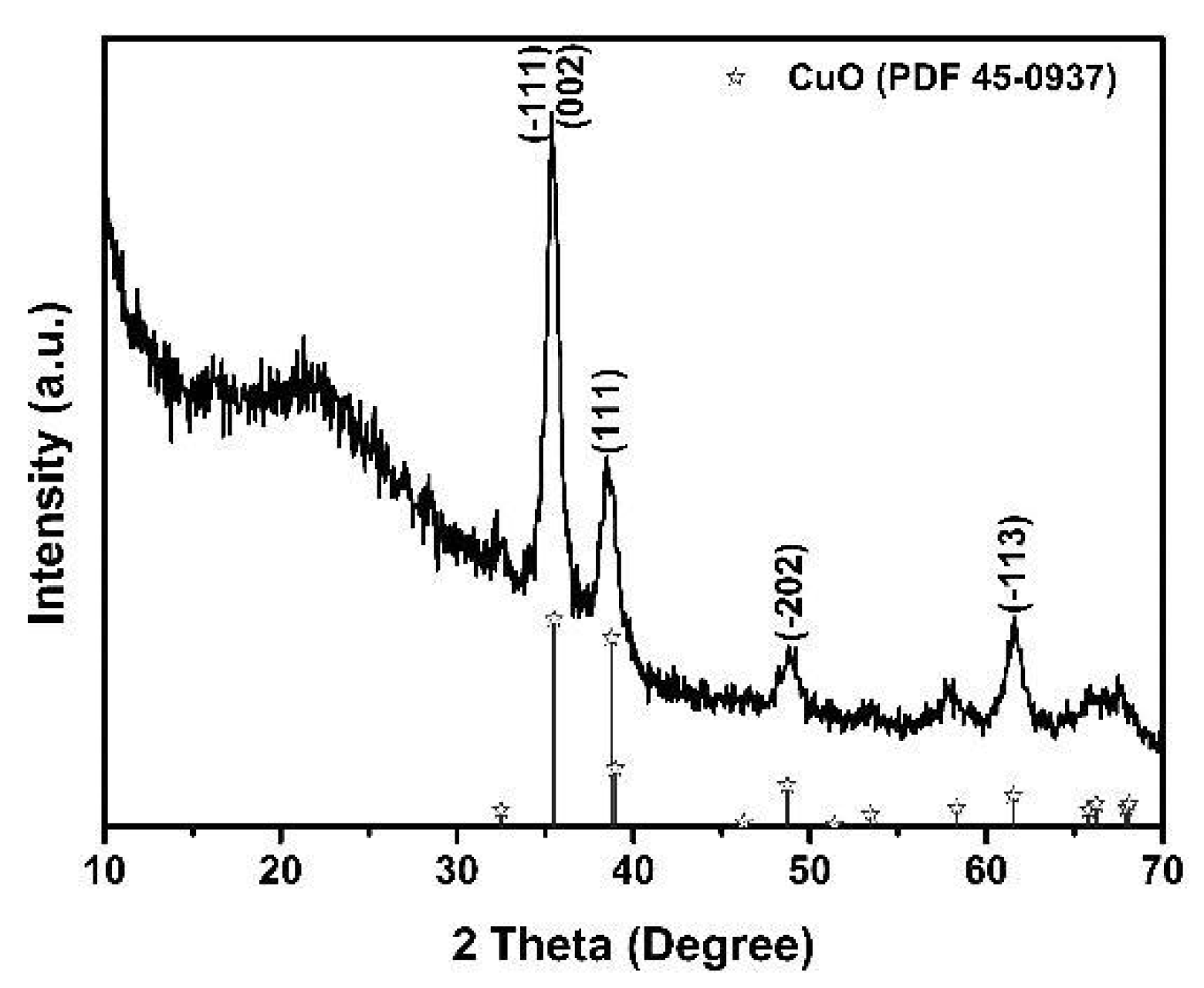
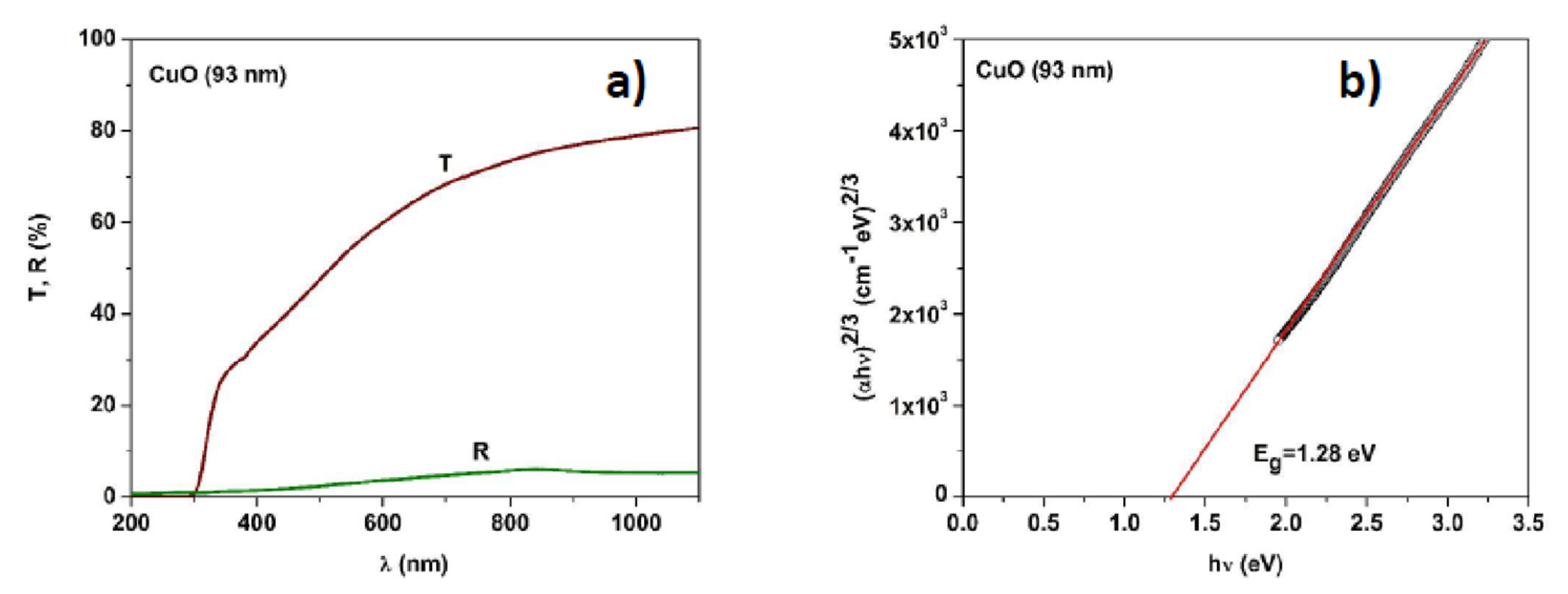
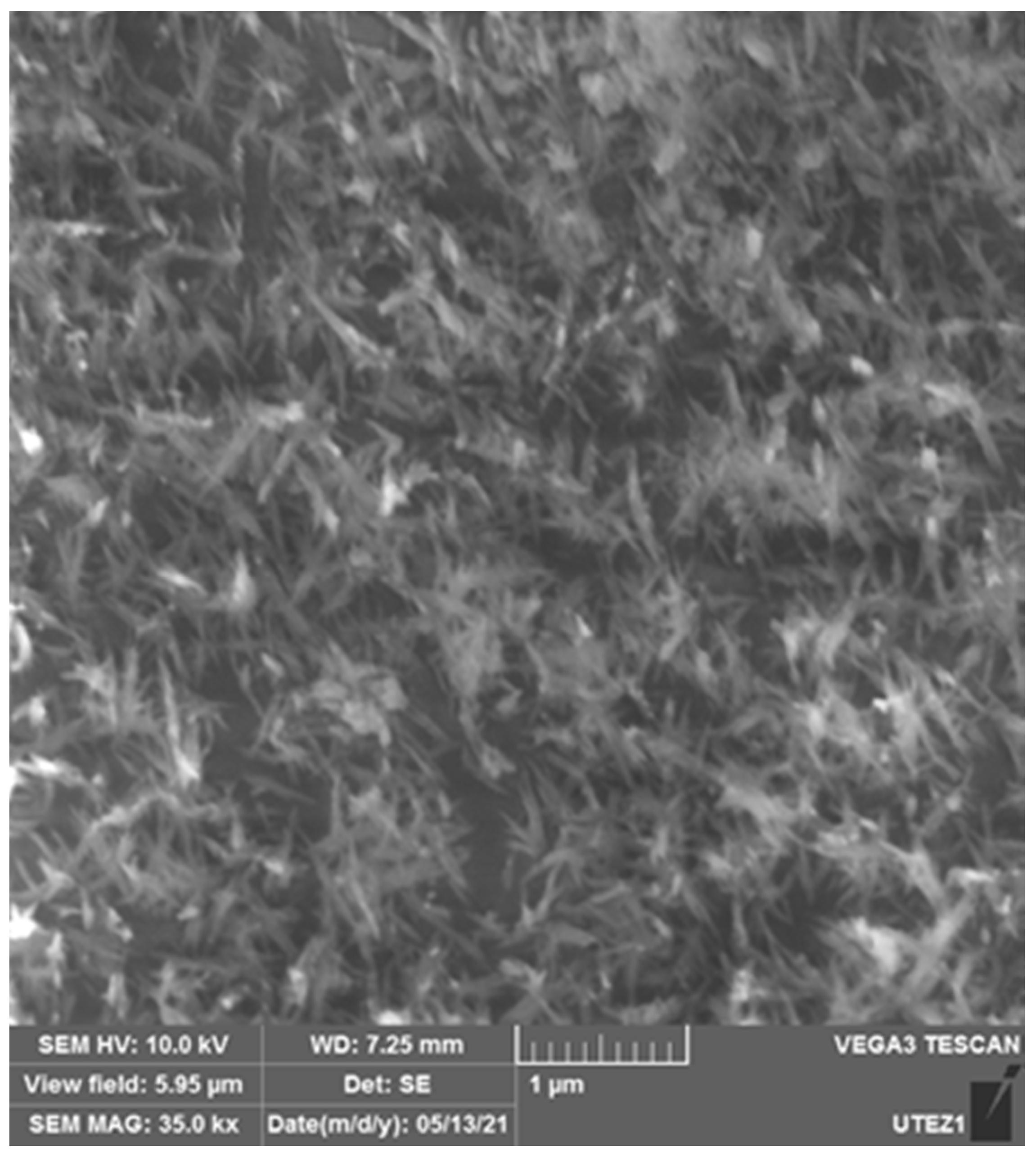
| Microcontroller: | PIC18F4550 | Operating Voltage: | 5 V |
| Voltage input: | Until 7.5 V | Voltage Range: | 0–13.25 V |
| Digital I/O pins: | 40 (2 PWM output) | Analog inputs: | 13 (10-bits resolution) |
| I/O pins (current): | 25 mA | 3.3V pins: | 1 (USB Peripheral) |
| Flash memory: | 32 Kbytes | SRAM: | 2048 bytes |
| EEPROM: | 256 bytes | Clock speed: | 20 MHz |
| Series: | NEMA23-AMT112S | Step Angle: | 1.8 degrees |
| Connection: | Bipolar | Voltage Rating: | 24–80 V |
| Pin or Wire Count: | 4 | Rotor Inertia: | 27.43 × 10−6 Kg*m2 |
| Current Rating: | 2.8 A | Resolution: | 0 PPR |
| Length: | 0.044 m | Unit Weight: | 0.015 kg |
| Holding torque (Max) | 1.9 N-m | Optimal speed (Max) | 5 RPS |
| Power supply voltage | 50 V | Output current | 5 A |
| Input voltage | 6 V | Power dissipation | 40 W |
| Clock frequency | 200 kHz | Chopping frequency | 60 kHz |
| Microcontroller (inside) | Toshiba® TB660 |
| Model | NX8048P070-011R | Color | 65K 65,536 colors |
| Layout size: | 0.181 × 0.108 × 0.0093 m | Resolution | 800 × 480 pixel |
| Touch type: | Resistive | Brightness | 300 nit |
| Backlight | LED | Weight | 0.265 kg |
| Operating Voltage | 4.75–6.5 V | Operating Current | 430 mA |
| Serial Port Baud rate | 2400–921,600 bps | FLASH Memory | 120 MB |
| State | Description |
|---|---|
| Q0: Idle state. | It waits for some user action to change any of the other states. |
| Q1: Variable verification status. | It sends the process variables to be displayed on the interface; once finished, it returns to status Q0. |
| Q2: SILAR process status. | In this status, the condition of the emergency stop button is verified; if it is activated, it sends a notification to the interface and returns to status Q0. Otherwise, it changes the interface to the process page and starts with the SILAR process. Once finished, it goes to state Q3. |
| Q3: Clean state. | The initial value is assigned to all the variables, counters, and flags that are used during the SILAR process; once finished, it goes to state Q0. |
| Q4: State of return to home 1. | It verifies the state of the emergency stop button; if it is active, it sends a notification to the interface and returns to state Q0. Otherwise, it returns the main motor (longitudinal displacement) to the initial position. Once finished, it goes to state Q7. |
| Q5: State of return to home 2. | It verifies the state of the emergency stop button; if it is active, it sends a notification to the interface and returns to state Q0. Otherwise, it returns the secondary motor (transverse displacement) to the initial position. Once finished, it goes to state Q7. |
| Q6: State of return to home 3. | It verifies the state of the emergency stop button; if it is active, it sends a notification to the interface and returns to state Q0. Otherwise, it returns both motors to the initial position. Once finished, it goes to state Q7. |
| Q7: Sensor display status. | It sends the Boolean status of the start stroke sensors and the emergency stop button to the interface. This state can be invoked both by a change of state of the emergency stop button, as well as by other states. |
| Q8: Free movement state. | It verifies the state of the emergency stop button; if it is active, it sends a notification to the interface and returns to state Q0. Otherwise, it moves the substrate holder to a station, up or down as indicated by the user from the interface. Once finished, it goes to state Q7. |
| State | Description |
|---|---|
| Q0: Initial state. | It verifies that the motors are in their initial position, in order to go to state Q1. In case they are not in their initial position, the motors are brought to the initial position. |
| Q1: Immersion status. | It verifies that the secondary motor (transverse displacement) is in its initial position. It checks if the pause button on the interface has been pressed to go to state Q5. If the pause button was not pressed, it checks the immersion time of the substrates in the current station (this time was previously assigned by the user from the interface). If the time is equal to Q0, it goes to state Q3; if not, it introduces the substrates in the solution and waits for the specified time. When the time is up, it goes to state Q2. |
| Q2: Emersion state. | It verifies that the secondary motor (transverse displacement) is in the immersion position and raises the substrates to the initial position. It also checks the pause button on the interface. If the pause button was pressed, it goes to state Q5; if not, it goes to state Q3. |
| Q3: Status of station displacement. | It verifies that the secondary motor (transverse displacement) is in its initial position. It checks the current station number; if it is the fourth station, it goes to state Q4. If not, it moves the substrates to the next station and returns to state Q1. |
| Q4: End of cycle status. | It verifies that the secondary motor (transverse displacement) is in its initial position and the main motor (longitudinal displacement) is in the fourth station. It returns to the first station and updates the information in the process progress interface SILAR. Once finished, it goes to state Q0. |
| Q5: Pause state. | It waits until the user presses the pause button again to be able to continue with the SILAR process. When the pause button is pressed again, it returns to the previous state from which the pause state was invoked. |
| Q6: Inverse station displacement status. | It verifies that the secondary motor (transverse displacement) is in its initial position. It checks the current station number. If it is the first station, the M state machine ends. If not, it moves the substrates one station back and ends the M state machine. This state can only be invoked by the user from the interface. |
Publisher’s Note: MDPI stays neutral with regard to jurisdictional claims in published maps and institutional affiliations. |
© 2021 by the authors. Licensee MDPI, Basel, Switzerland. This article is an open access article distributed under the terms and conditions of the Creative Commons Attribution (CC BY) license (https://creativecommons.org/licenses/by/4.0/).
Share and Cite
Calixto-Rodriguez, M.; Valdez Martínez, J.S.; Meneses-Arcos, M.A.; Ortega-Cruz, J.; Sarmiento-Bustos, E.; Reyes-Mayer, A.; González-Castañeda, M.; Domínguez García, R.O. Design and Development of Software for the SILAR Control Process Using a Low-Cost Embedded System. Processes 2021, 9, 967. https://doi.org/10.3390/pr9060967
Calixto-Rodriguez M, Valdez Martínez JS, Meneses-Arcos MA, Ortega-Cruz J, Sarmiento-Bustos E, Reyes-Mayer A, González-Castañeda M, Domínguez García RO. Design and Development of Software for the SILAR Control Process Using a Low-Cost Embedded System. Processes. 2021; 9(6):967. https://doi.org/10.3390/pr9060967
Chicago/Turabian StyleCalixto-Rodriguez, M., Jorge S. Valdez Martínez, M. A. Meneses-Arcos, Jose Ortega-Cruz, E. Sarmiento-Bustos, Adriana Reyes-Mayer, Michelle González-Castañeda, and Rodolfo Omar Domínguez García. 2021. "Design and Development of Software for the SILAR Control Process Using a Low-Cost Embedded System" Processes 9, no. 6: 967. https://doi.org/10.3390/pr9060967
APA StyleCalixto-Rodriguez, M., Valdez Martínez, J. S., Meneses-Arcos, M. A., Ortega-Cruz, J., Sarmiento-Bustos, E., Reyes-Mayer, A., González-Castañeda, M., & Domínguez García, R. O. (2021). Design and Development of Software for the SILAR Control Process Using a Low-Cost Embedded System. Processes, 9(6), 967. https://doi.org/10.3390/pr9060967








